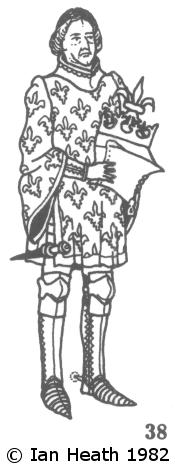
Try Amazon Audible Premium Plus and Get Up to Two Free Audiobooks
KING CHARLES VI 1380-1422
An extract from Armies of the Middle Ages, Volume 1by Ian Heath



38. KING CHARLES VI 1380-1422
It is clear from contemporary written accounts that crowns, coronets and fillets of gold, sometimes jewel-encrusted, were often worn over the helmets of kings, princes and high-ranking noblemen in battle as a somewhat ostentatious means of identification. Henry V, for example, had a fleuron hacked from the crown he was wearing over his helmet at Agincourt, and the episode of Richard III's gold crown, found in a thorn bush after the Battle of Bosworth, is well known. At Aljubarrota in 1385, so Froissart tells us, Henry II of Castile had a great helm encircled with a coronet of gold and jewels that was valued at as much as 20,000 francs. In the figure here, from a source of 1403, Charles holds a great helm of a late type which appeared c. 1390 and was worn until the 1420s by when it had been relegated to tournament use, for which it had probably always been principally intended anyway; Henry V wore a very similar but slightly less 'frog-mouthed' helm at Agincourt. Charles' has both a crown and a fleur-de-lis crest, just like the helm which King Philip VI is recorded to have worn during the Cassel campaign.
In total contradiction of the purpose for which such crowned helmets were worn, when a king went into battle it was often deemed expedient to mitigate the danger to him by identically equipping several other men. At Poitiers, for example, King John II had 19 knights dressed like himself, and at Shrewsbury in 1403 4 barons dressed like Henry IV were all killed. Even at Agincourt one source alleges that Henry V had 2 men dressed like himself, and that both were killed in the battle. Although such ruses thereby clearly saved the life of many a king there must have been a severe risk of causing considerable confusion in one's own army, which could not always have been too sure exactly where the real king was.
Note his basin-style haircut, similar to that of the 11th century Normans. This came into vogue at the very end of the 14th century or at the beginning of the 15th and persisted until the 1470s, when hair again became longer at the sides even though it remained short in front. Beards were generally uncommon after the early-15th century.